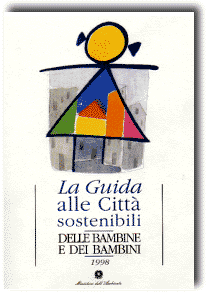|
| ||
| The Children’s Guide to Sustainable Cities | ||
| by Gato Medici | ||
Life in our cities is becoming increasingly hard; trees and parks are few and far between, the air is by now unbreathable as a result of industrial pollution and traffic, and when the warm season arrives a mantle of ozone descends upon the urban centres. We are crowded out by cars, which even mount the pavements forcing us to pick our way along in a sort of obstacle-race, which becomes impossible for old people or mothers with prams.
In general, what children nowadays recognise as food is the kind sold in the supermarkets, and they haven’t got the faintest idea about how what they eat is actually produced. And these are only a few of the scenarios which are now typical of our inner cities. To publicise and enhance the experiences of those urban centres which are working towards developing a better quality of life for their inhabitants, the Department of the Environment has published the “Children’s Guide to Sustainable Cities”. We would highly recommend this efficient guide to local administrations, since it contains a wealth of information useful for developing an urban environment of human dimensions. It includes a series of documents, comprising the Rio de Janeiro Agenda 1992, the Aalborg Map 1994, the Search for a car-free city 1991, the Map of the educative City of Barcelona 1991, up to the Habitat 2 of Istanbul, 1996, and the text of the Department of the Environment ruling of 3 August 1998, which help the reader to find his way about the subject. But undoubtedly the most interesting aspect concerns the new initiatives launched in the various cities, among them the “Participative planning workshops” in Empoli, the “Safe Routes Plan” designed to link the schools, parks and health and sports structures in Ercolano, “The Children’s Farm” in Florence, the first example of a children’s city farm in Italy, where “…nature is not taught but lived….”, and many others. The network of the “Sustainable Cities” is growing, giving us reason to hope that the coming millennium will see our cities green, clean, silent and beautiful, in short truly transformed to become person-friendly. The guide may be requested free. “Children’s Guide to Sustainable Cities” Istituto degli Innocenti - P.zza S.S. Annunziata, 12 - 50122 Firenze, Italy ph. (+039) 055 2037.359/ fax (+039) 055 2037.207 - http://www.cittasostenibili.minori.it | ||
|

